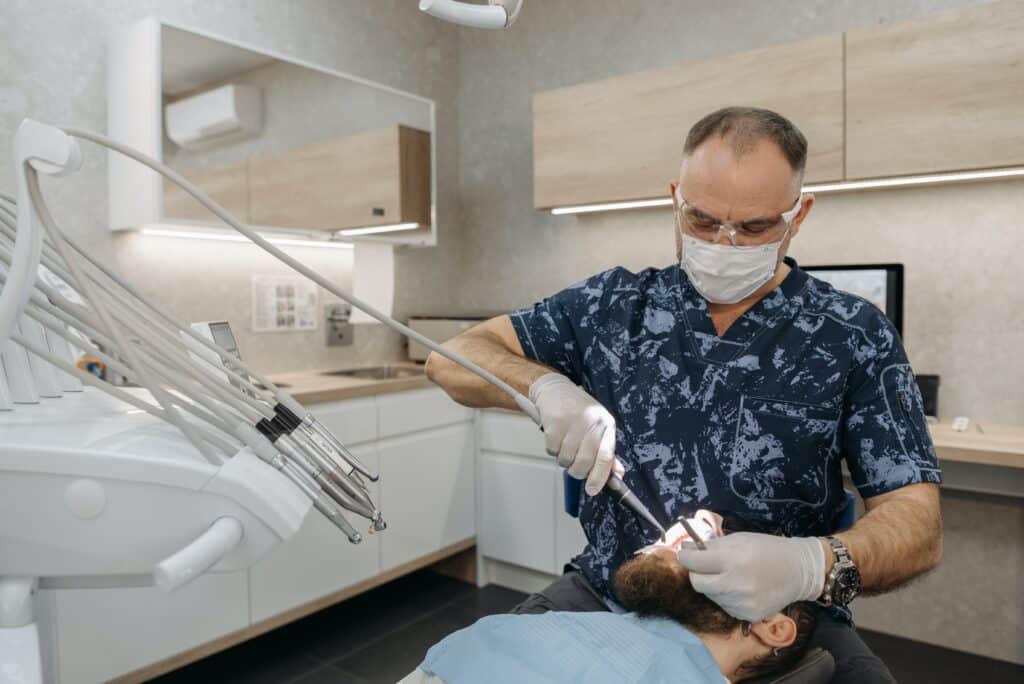Services

Restorations
Composites, commonly known as “white fillings” are the standard materials to restore decayed teeth
As opposed to amalgams(aka silver fillings) composites “adhere” to the teeth which make the procedure LESS INVASIVE and the teeth stay solid and less prone to breakage after extensive amalgam fillings
Whether it be anterior or posterior, a composite filling will blend in beautifully with the neighboring teeth.
Root canals
Unfortunately, sometimes with deep cavities, severe blows or accidents, the nerve of the tooth is damaged and rarely prone to healing after that kind of trauma or inflammation; so in order to save the tooth from getting pulled out we choose to do a “root canal”; keeping your natural teeth is far better option than any artificial replacement alternative.
A root canal is mainly the cleaning and disinfection of the canal or canals of a tooth and hermetically sealing them; it can be done in one or two appointments;


Whitening
A beautiful smile is important in all aspects of life; whether it be socially or work related, a smile increases one’s confidence and self esteem, especially if the teeth AND gums are healthy;
Teeth become darker or yellower with age, consumption habits(coffee, wine, smoking…) this is where whitening goes into play to regain to make your teeth regain a whiter shade;
Whether you choose an in-clinic whitening or at home whitening, everybody may benefit from the results
Bear in mind though, “fillings” and “crowns” do not change color; So, if this was in your treatment plan, better to have your whitening over and done with at least 2 weeks before your treatements so the shade of your teeth is final and stabilised
One more thing, we suggest using a toothpaste for sensitive teeth 2 weeks prior to your whitening and continue for another 2 weeks after; Certain persons may experience temporary sensitivity during the whitening, which will dissipate afterwards;
Veneers
They are thin layers of porcelain or composite resin used to improve the shape of your teeth, close gaps between your teeth or just improve the harmony of an otherwise amazing smile.
Porcelain: made in the lab, they are more durable, more esthetic and give better results and don’t change color…but more expensive than.
Composite resin: made in the clinic, give optimal results, but tend to change color with time and consumption habits( coffee, wine, smoking…)…but are more affordable.


Gum disease
Sick or enflamed gums may seriously jeopardize the future of the concerned teeth;
Bleeding, swelling, halitosis and loose teeth are just a few of the precursor signs;
Before this reaches the point of no return your dentist must have advised you numerous times to take the necessary preventive measures;
This is why it’s absolutely important to take care of the 3 Pillars of Prevention BEFORE all this occurs:
- Brush your teeth impeccably at least twice a day
- Floss adequately, at least once a day, preferably before going to bed
- HAVE A PROFESSIONAL CHECK-UP AND CLEANING TWICE A YEAR; this will prevent and avoid serious repercussions related to the lifespan of your teeth…des fois à vie;
Certain patients, who have already advanced stages of gum disease would need more frequent professional cleanings-like 3 or 4 times a year…sometimes for life
Children
We start to see children around the time when their first teeth come out – 8 to 10 months
The purpose of the first appointment is to:
– familiarise the child with the dental clinic environment and establish and build a rapport of trust with the dentist
– Teach the parents (especially if it’s their first born) the good hygiene habits to instill into their child’s daily routine
– Detect cavities, pathologies, structural or otherwise, so that treatments would be reduced to their simplest and minimal form
– It lasts 5 to 10 minutes



Crowns, bridges and crowns over implants
A crown is used to protect a heavily restored tooth, severely damaged or fractured tooth or one that has a crack (due to an accident, a blow or biting on something hard )
Most of the time it is made of porcelain that blends in beautifully with the surrounding teeth
A good quality crown is achieved in 2 appointments;
One appointed crowns, machine milled are no match to a crown made by an outstanding technician/artist which replicates the natural aspect, shade and translucidity of the natural tooth
Bridges:
Bridges are used to replace one or more missing teeth; they’re fixed and necessitate 2 or 3 appointments;
The dentist will grind the neighbouring teeth to make room for the porcelain ; it’s mandatory that the aforementioned teeth need to have an good foundation to support the bridge;
Usually a bridge is not recommended if the neighbouring teeth are healthy(no cavities) or have very small conservative fillings
Why not a bridge ?
To do so, the dentist will grind around 75% of “sound” and “healthy”teeth in order to replace ONE missing tooth
In doing so, a ground tooth has a 20% risk of needing a root canal afterwards…and root canals don’t have a 100% success rate
Crowns over implants:
They are the ideal solution to replace one or many missing teeth
Success rate of implants have gone beyond 95 % the last couple of decades
Almost anybody can have an implant; Although, the success rate goes way down if the patient is a smoker or has an inadequate oral hygiene;
Sometimes, prior to replacing an implant, a patient might need a bone graft, should there not be enough bone volume; and this, will lengthen the timeline
Anticipate 5 to 6 months to have a crown over an implant
Add on another 3 to 4 months should a bone graft be needed
Wisdom teeth extraction
With the Evolution, our jaws are getting smaller and could not accommodate all our teeth without crowding; and more often than not the 3rd molars-or wisdom teeth- don’t have enough room to come out straight, let alone just come out; so oftentimes they stay completely impacted inside the jawbone or come out partially and become half covered with gum…which with time could get infected…or given their position the wisdom teeth could damage the adjacent tooth by causing resorption or a cavity which, in most case would be difficult to restore
So, unfortunately, for the majority of the younger population, wisdom teeth extraction is a necessary evil.
Anticipate one or two days rest after the surgery
